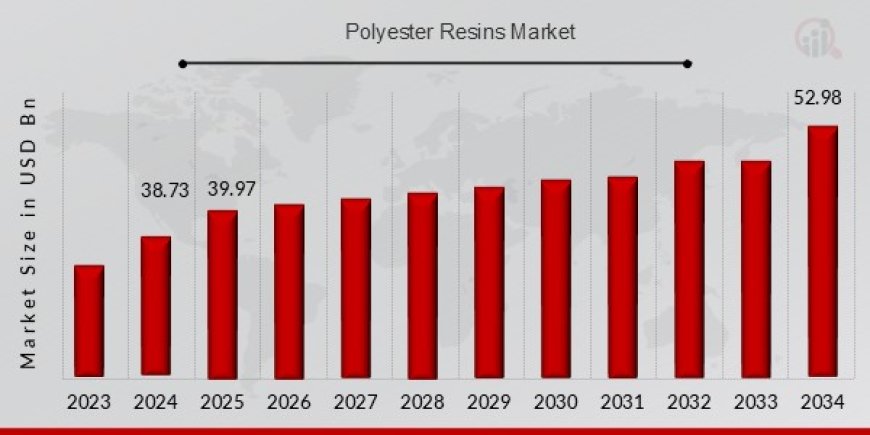Polyester Resins Market: Growth Trends, Key Applications, and Future Outlook
The Polyester Resins Market was estimated at USD 38.73 billion in 2024. It is expected to grow from USD 39.97 billion in 2025 to USD 52.98 billion by 2034.

The polyester resins market has emerged as a significant segment within the global chemicals and materials industry, driven by rising demand across automotive, construction, marine, and electrical applications. Polyester resins are versatile thermosetting polymers known for their durability, chemical resistance, and cost-effectiveness. These resins are widely used in composite materials, coatings, and adhesives, making them vital in both industrial and consumer product manufacturing.
Market Overview
As of 2025, the global polyester resins market is witnessing steady growth, driven by increasing industrialization, urban infrastructure development, and the shift toward lightweight composite materials. According to recent market analysis, the market is projected to register a compound annual growth rate (CAGR) of around 3.18% over the next five years. The Asia-Pacific region remains the largest consumer, with China and India playing key roles due to robust construction activity and manufacturing expansion.
There are two main types of polyester resins: unsaturated polyester resins (UPRs) and saturated polyester resins (SPRs). UPRs are widely used in the production of fiberglass-reinforced plastics, automotive parts, and pipes. SPRs are more common in powder coatings, can coatings, and industrial paints. The versatility of these resins has led to their widespread adoption across various sectors.
Key Drivers of Growth
- Construction and Infrastructure Development: The construction industry is a primary driver of polyester resin demand, particularly for applications such as panels, tanks, roofing, and cladding. UPRs are preferred for these applications due to their excellent mechanical strength and corrosion resistance.
- Automotive and Transportation Sector: The push toward lightweight and fuel-efficient vehicles has spurred demand for composite materials. Polyester resins, especially when reinforced with glass fiber, offer high strength-to-weight ratios, making them ideal for automotive body panels, hoods, and structural components.
- Wind Energy Industry: The growing renewable energy sector, especially wind power, has boosted demand for fiberglass-reinforced polyester resins used in the production of wind turbine blades. The global shift toward sustainable energy sources further strengthens this trend.
- Marine and Industrial Applications: Polyester resins are also heavily utilized in the marine industry for boat hulls and components due to their water resistance. Their chemical resistance also makes them suitable for storage tanks and piping systems in industrial settings.
Challenges Facing the Market
Despite the growing demand, the polyester resins market faces several challenges. One major concern is the environmental impact of thermosetting plastics, which are generally not recyclable. Stringent environmental regulations in Europe and North America are pressuring manufacturers to explore bio-based alternatives and improve end-of-life recyclability.
Another issue is price volatility of raw materials. Polyester resins are derived from petrochemicals, and fluctuations in crude oil prices can significantly affect production costs. This can lead to unpredictability in pricing and profitability for manufacturers and suppliers.
Innovations and Trends
In response to environmental concerns, bio-based polyester resins are gaining traction. These are made from renewable resources such as vegetable oils and are being developed to match the performance of traditional resins. Though still in the early stages of commercial adoption, they offer a promising solution for reducing carbon footprints and meeting sustainability goals.
Another trend is the development of high-performance resin systems with enhanced thermal stability, mechanical strength, and weather resistance. These advancements expand the usability of polyester resins in demanding environments, such as aerospace and electronics.
Moreover, digitalization in manufacturing processes, including automation and quality control through AI, is improving the production efficiency and consistency of polyester resin products. These technological advancements are expected to enhance market competitiveness and enable customization for specific applications.
Regional Insights
- Asia-Pacific remains the largest and fastest-growing market, with China being a major hub for production and consumption. Growth is driven by urbanization, automotive manufacturing, and government-backed infrastructure projects.
- North America shows stable growth due to the presence of established end-user industries such as marine, aerospace, and automotive.
- Europe is focusing on sustainable and eco-friendly materials, leading to increased R&D in green polyester resin formulations.
Future Outlook
The polyester resins market is poised for continued growth, supported by robust demand in construction, automotive, and renewable energy. However, to sustain long-term progress, the industry must address environmental concerns and adapt to evolving regulatory frameworks. Companies that invest in sustainable materials, innovation, and efficient manufacturing will be better positioned to lead the market.
In conclusion, polyester resins remain a cornerstone material in the modern industrial landscape. With evolving technologies and shifting consumer expectations, the market is undergoing a transformation toward greener, more versatile, and high-performance resin systems. The coming years will likely witness a stronger emphasis on sustainability, innovation, and regional diversification as key levers of market growth.






























































![https //g.co/recover for help [1-866-719-1006]](https://newsquo.com/uploads/images/202506/image_430x256_684949454da3e.jpg)
























![How Smart PMs Scale Their Careers in Any Org [TPG Live Recap]](https://tpgblog.com/wp-content/uploads/2025/06/2025-06-12-thumbnail-action.png?#)





















































